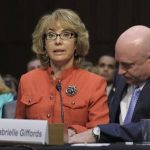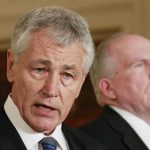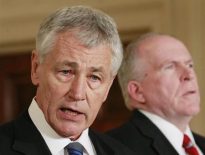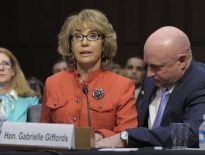WASHINGTON (AP) — Just as President Barack Obama is pushing new initiatives on gun control and immigration, the gloomy old problem of a sluggish economy is elbowing its way back into prominence. Consumer confidence is falling, the economy is contracting and large automatic spending cuts are threatening to hit the Pentagon and other programs, with uncertain consequences.

These troubles arise as Obama’s public approval is improving and as he begins to use his sway to promote the key features of his second-term agenda. The White House, the Federal Reserve and independent economists attributed the shrinkage in gross domestic product and the drop in consumer confidence to one-time events and said underlying economic factors were still showing encouraging signs.
But in politics, power resides in the moment. Any immediate economic setback – or the perception of one – could weaken Obama’s clout or at least distract him as he carefully tries to put his imprint on initiatives dealing with immigration and gun violence.
At the White House, there was no evidence of a course alteration. And White House officials expressed confidence in consumption and investment trends that showed evidence of strength.
But the Commerce Department announcement Wednesday that the economy shrank at an annual rate of 0.1 percent came a day after the Conference Board reported a sharp decline in consumer confidence in January. That drop, together with one in December, erased consumer confidence that had built up in 2012.
What’s more, the new data comes just two days before the government releases the January unemployment report, which economists believe will stay at the still-high rate of 7.8 percent, where it has held for two months.
“What’s most critical to consumer confidence is employment,” said Lynn Franco, director of economic indicators at the Conference Board. “We’ve had spurts where we’ve had strong job growth and we’ve seen a rebound in confidence, and then suddenly you have a pullback in employment and you get a pullback in confidence. So we need a convincing story, and that’s going to take several months of jobs growth.”
Analysts said the economy is still on track to grow steadily if modestly at a roughly 2 percent pace, as long as the housing and auto industries continue to recover.
The Commerce Department attributed the economic contraction mainly to companies restocking at a slower rate and to reductions in government spending on defense. While companies will ultimately have to rebuild their inventories, the cuts in defense spending could offer a hint of things to come.
The administration argued that the 22 percent reduction in defense spending was partly in anticipation of automatic spending cuts that were going to take effect at the beginning of the year. Obama and congressional Republicans averted that so-called fiscal cliff by extending Bush-era tax rates to all but the wealthiest Americans.
But the deal simply delayed the automatic cuts until March 1. At that point, the Pentagon faces across-the-board cuts of 7 percent, while domestic programs will have to shrink by 5 percent. Some analysts believe that if those cuts are allowed to occur, as some Republicans are now suggesting, the economy could lose a half a percentage point of growth.
Some in the business community hope the experience in the last quarter will alert lawmakers to the potential economic damage the automatic cuts could create.
“I don’t think any time you see a reduction in economic growth that it’s good news,” White House press secretary Jay Carney conceded Wednesday.
But he cautioned, “We need to make sure that in Washington we are not taking actions that undercut that progress that we have been making and can continue to make and will continue to make.”
Carney said letting the automatic cuts take effect is a “sort of political brinksmanship of the kind that results in one primary victim, and that’s American taxpayers, the American middle class.”
Still, the White House insists the only alternative to those cuts is a mix of savings and new tax revenue. Republicans say the $600 billion in revenue they already gave Obama as part of the New Year’s fiscal cliff deal is enough. They insist that if he wants different spending cuts than those due to start on March 1, he should submit a new plan.
But the White House has been eager to move away from fiscal and budget fights, ready to use the president’s re-election and the uptick in his popularity to push his noneconomic agenda.
On Tuesday, he traveled to Las Vegas to push for an overhaul in immigration. On Monday, he is traveling to Minneapolis to promote his proposals to reduce gun violence.
The issues are not simple ones for Obama. The economy and the nation’s debt still rank higher than immigration and guns as issues in the mind of the public. Moreover, Obama has to navigate gingerly with Congress on immigration, where a fragile coalition of Democrats and Republicans is assembling legislation that, among other things, could provide a path to citizenship for 11 million illegal immigrants in the U.S.
Obama has vowed to use his bully pulpit to build public support for his new agenda. Defending his economic stewardship was not supposed to be part of the playbook.





